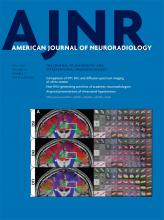Table of Contents
Perspectives
Patient Safety
- Full Dose-Reduction Potential of Statistical Iterative Reconstruction for Head CT Protocols in a Predominantly Pediatric Population
The authors set out to determine the maximum level of statistical iterative reconstruction that can be used to establish dose-reduced head CT protocols in a primarily pediatric population while maintaining similar appearance and level of image noise in the reconstructed image. Dose-reduced head protocols using an adaptive statistical iterative reconstruction were compared for image quality with the original filtered back-projection reconstructed protocols in a phantom and CT dose index and image noise magnitude were assessed in 737 pre- and post-dose-reduced examinations. Implementation of 40% and 60% adaptive statistical iterative reconstruction led to an average reduction in the volume CT dose index of 43% for brain, 41% for orbit, 30% for maxilla, 43% for sinus, and 42% for temporal bone protocols for patients between 1 month and 26 years of age, while improving the contrast-to-noise ratio of low-contrast soft-tissue targets.
Academic Perspectives
- Non-Relative Value Unit–Generating Activities Represent One-Fifth of Academic Neuroradiologist Productivity
Four full-time neuroradiologists, working an average of 50% clinical and 50% academic activity, systematically recorded all the non-relative value unit– generating consults and conferences in which they were involved during 3 months. The 4 neuroradiologists working an average of 50% clinical activity interpreted 4241 RVU-generating imaging studies, representing 8152 work RVUs. During the same period, they recorded 792 non-RVU-generating study reviews as part of consults. The authors propose a simple Web-based smartphone app to record and quantify non-RVU-generating activities including consults, clinical conferences, and tumor boards.
General Contents
- Mapping the Orientation of White Matter Fiber Bundles: A Comparative Study of Diffusion Tensor Imaging, Diffusional Kurtosis Imaging, and Diffusion Spectrum Imaging
The authors evaluated fiber bundle orientations from DTI and diffusional kurtosis compared with diffusion spectrum imaging as a criterion standard to assess the performance of each technique. DTI, diffusional kurtosis imaging, and diffusion spectrum imaging datasets were acquired during 2 independent sessions in 3 volunteers. While orientation estimates from all 3 techniques had comparable angular reproducibility, diffusional kurtosis imaging decreased angular error throughout the white matter compared with DTI. Diffusion spectrum imaging and diffusional kurtosis imaging enabled the detection of crossing-fiber bundles. They conclude that fiber bundle orientation estimates from diffusional kurtosis imaging have less systematic error than those from DTI.
- Iron and Non-Iron-Related Characteristics of Multiple Sclerosis and Neuromyelitis Optica Lesions at 7T MRI
Twenty-one patients with MS and 21 patients with neuromyelitis optica underwent 7T high-resolution 2D-gradient-echo-T2* and 3D-susceptibility-weighted imaging. An in-house-developed algorithm was used to reconstruct quantitative susceptibility mapping from SWI. Of the patients with MS, 19 (90.5%) demonstrated at least 1 quantitative susceptibility mapping–hyperintense lesion, and 11/21 (52.4%) had iron-laden lesions. No quantitative susceptibility mapping–hyperintense or iron-laden lesions were observed in any patients with neuromyelitis optica. The authors conclude that ultra-high-field MR imaging may be useful in distinguishing MS from neuromyelitis optica.
- Atypical Presentations of Intracranial Hypotension: Comparison with Classic Spontaneous Intracranial Hypotension
The authors evaluated the clinical records and neuroimaging of patients with spontaneous intracranial hypotension from September 2005 to August 2014. Patients with classic spontaneous intracranial hypotension (n = 33) were compared with those with intracranial hypotension with atypical clinical presentation (n = 8). There was no significant difference in dural enhancement, subdural hematomas, or cerebellar tonsil herniation. Patients with atypical spontaneous intracranial hypotension had significantly more elongated anteroposterior midbrain diameter compared with those with classic spontaneous intracranial hypotension, and shortened pontomammillary distance. In this population, patients with atypical spontaneous intracranial hypotension showed a more chronic syndrome compared with classic spontaneous intracranial hypotension, more severe brain sagging, lower rates of clinical response, and frequent relapses.
- Endovascular Management of Tandem Occlusion Stroke Related to Internal Carotid Artery Dissection Using a Distal to Proximal Approach: Insight from the RECOST Study
The authors analyzed all carotid artery dissection tandem occlusion strokes and isolated anterior circulation occlusions from their ongoing prospective stroke data base. For carotid artery dissection, the revascularization procedure consisted of initial distal recanalization by a stent retriever in the intracranial vessel. Following assessment of the circle of Willis, ICA stent placement was only performed in case of insufficiency. Two hundred fifty-eight patients with an anterior circulation stroke were analyzed, including 20 with carotid artery dissection–related occlusion. Only 5 carotid artery dissections (25%) necessitated cervical stent placement. No early ipsilateral stroke recurrence was recorded, despite the absence of stent placement in 15 patients (75%) with carotid artery dissection. Mechanical endovascular treatment of carotid artery dissection tandem occlusions is safe and effective compared with isolated anterior circulation occlusion stroke therapy. The authors favor a complete evaluation of the circle of Willis in these patients, which requires a contralateral femoral puncture, allowing selective contralateral common carotid and vertebrobasilar catheterizations.








